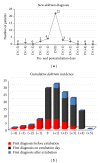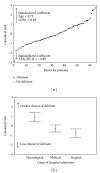Delirium during Weaning from Mechanical Ventilation
- PMID: 24982804
- PMCID: PMC4058843
- DOI: 10.1155/2014/546349
Delirium during Weaning from Mechanical Ventilation
Abstract
Background. We compare the incidence of delirium before and after extubation and identify the risk factors and possible predictors for the occurrence of delirium in this group of patients. Methods. Patients weaned from mechanical ventilation (MV) and extubated were included. The assessment of delirium was conducted using the confusion assessment method for the ICU and completed twice per day until discharge from the intensive care unit. Results. Sixty-four patients were included in the study, 53.1% of whom presented with delirium. The risk factors of delirium were age (P = 0.01), SOFA score (P = 0.03), APACHE score (P = 0.01), and a neurological cause of admission (P = 0.01). The majority of the patients began with delirium before or on the day of extubation. Hypoactive delirium was the most common form. Conclusion. Acute (traumatic or medical) neurological injuries were important risk factors in the development of delirium. During the weaning process, delirium developed predominantly before or on the same day of extubation and was generally hypoactive (more difficult to detect). Therefore, while planning early prevention strategies, attention must be focused on neurological patients who are receiving MV and possibly even on patients who are still under sedation.
Figures




References
-
- Ouimet S, Kavanagh BP, Gottfried SB, Skrobik Y. Incidence, risk factors and consequences of ICU delirium . Intensive Care Medicine. 2007;33(1):66–73. - PubMed
-
- Levy N, Kollef MH, Ahrens TS, Schaiff R, Prentice D, Sherman G. The use of continuous intravenous sedation is associated with prolongation of mechanical ventilation. Chest. 1998;114(2):541–548. - PubMed
-
- Sanders RD. Delirium, neurotransmission, and network connectivity: the search for a comprehensive pathogenic framework. Anesthesiology. 2013;118(3):494–496. - PubMed
-
- Shehabi Y, Riker RR, Bokesch PM, Wisemandle W, Shintani A, Ely EW. Delirium duration and mortality in lightly sedated, mechanically ventilated intensive care patients. Critical Care Medicine. 2010;38(12):2311–2318. - PubMed
LinkOut - more resources
Full Text Sources
Other Literature Sources

